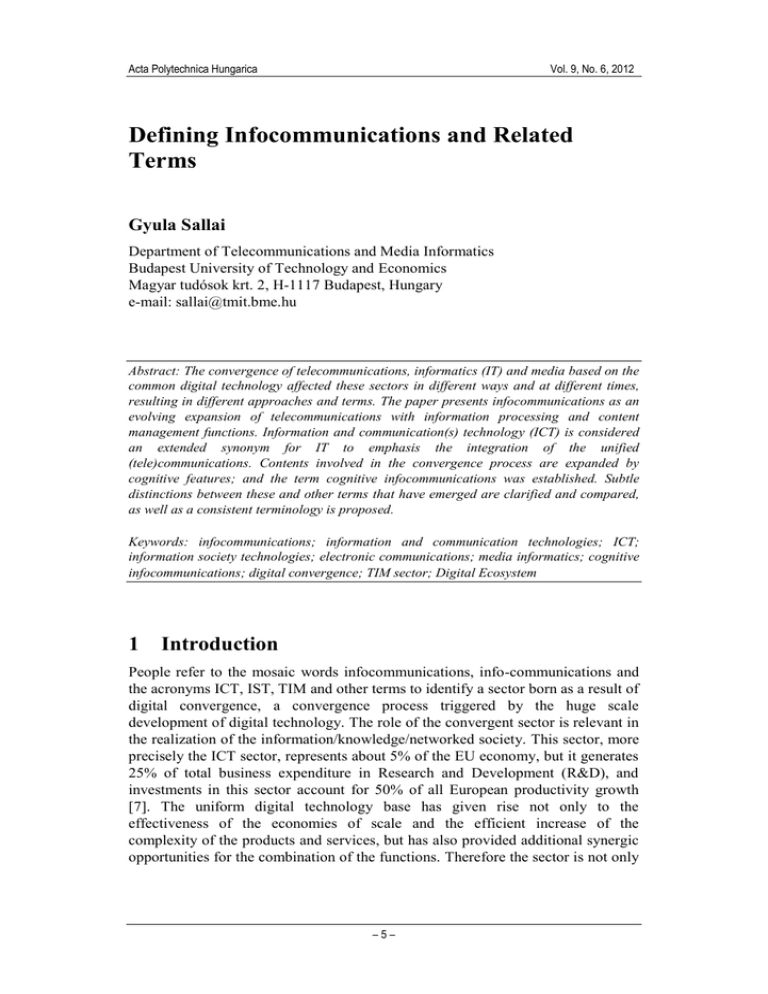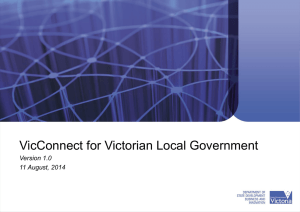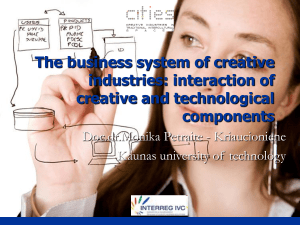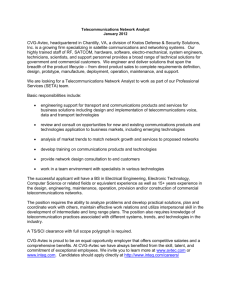Defining Infocommunications and Related Terms Gyula Sallai
advertisement

Acta Polytechnica Hungarica Vol. 9, No. 6, 2012 Defining Infocommunications and Related Terms Gyula Sallai Department of Telecommunications and Media Informatics Budapest University of Technology and Economics Magyar tudósok krt. 2, H-1117 Budapest, Hungary e-mail: sallai@tmit.bme.hu Abstract: The convergence of telecommunications, informatics (IT) and media based on the common digital technology affected these sectors in different ways and at different times, resulting in different approaches and terms. The paper presents infocommunications as an evolving expansion of telecommunications with information processing and content management functions. Information and communication(s) technology (ICT) is considered an extended synonym for IT to emphasis the integration of the unified (tele)communications. Contents involved in the convergence process are expanded by cognitive features; and the term cognitive infocommunications was established. Subtle distinctions between these and other terms that have emerged are clarified and compared, as well as a consistent terminology is proposed. Keywords: infocommunications; information and communication technologies; ICT; information society technologies; electronic communications; media informatics; cognitive infocommunications; digital convergence; TIM sector; Digital Ecosystem 1 Introduction People refer to the mosaic words infocommunications, info-communications and the acronyms ICT, IST, TIM and other terms to identify a sector born as a result of digital convergence, a convergence process triggered by the huge scale development of digital technology. The role of the convergent sector is relevant in the realization of the information/knowledge/networked society. This sector, more precisely the ICT sector, represents about 5% of the EU economy, but it generates 25% of total business expenditure in Research and Development (R&D), and investments in this sector account for 50% of all European productivity growth [7]. The uniform digital technology base has given rise not only to the effectiveness of the economies of scale and the efficient increase of the complexity of the products and services, but has also provided additional synergic opportunities for the combination of the functions. Therefore the sector is not only –5– Gy. Sallai Defining Infocommunications and Related Terms an integration of previously independent sectors, but it is dynamically expanded by new products and services, and thereby its scope is continuously changing and expanding. Different terms are formed for the same entity from different aspects; the same term is often used in many different contexts. When we use a term, it is a shortcut that allows us to refer to an entity without having to repeatedly describe it or precisely define it. The selected term in itself does not define content; it is created institutionally, or emerges from usage within a specific context which is based on previous meaning or meanings and in turn influences its interpretation. These issues in the respect of the information society versus the knowledge society are clearly presented in [3], while some aspects in relation to the abovementioned terms are discussed in [2, 13, 14, 30]. Institutions and organizations usually use these terms with their general meaning without precise definition, but rather with describing characteristic elements of their activity [11, 17, 20]. The detailed definition, based on an international standard classification of activities, was considered in order to obtain sector indicators [26]. The information technology and telecommunications sectors were first affected by digital convergence process, which was manifested in the unification of their technologies, in the integration of their markets and in the harmonization of their regulation. The convergence process affected the two sectors in different ways; different approaches, models and terms were formulated on both sides, and the same term is often used in different contexts. Then the electronic media and content producing sectors also entered the convergence process, which resulted in the birth of the first real convergent sector. The term differences were inherited. The process of the convergence has been further extended; synergic combinations with the cognitive science and other content and application areas have been realized. For the deployment of the synergies the market structure of the concerned sectors is reconsidered, and the regulation of the converging areas is harmonized. In the body of the paper, first we present the digital convergence process and terms from the telecommunications approach, and then from the aspect of the information technology. We try to clarify the subtle distinctions and build up a consistent terminology using a series of layer models and a colour mixing scheme. 2 Telecommunications, Electronic Communications, Infocommunications Digital technology has radically reshaped telecommunications. From the point of view of telecommunications, four main overlapping phases of the digital convergence process have been identified [30]. To present the evolutionary phases, we use a simple value chain model which represents the consequent valuegenerating functions from information sources to the usage at the destination (Figure 1). –6– Acta Polytechnica Hungarica Vol. 9, No. 6, 2012 Figure 1 Phases of digital convergence 1) Separated internal digitization. Traditionally, the various contents have been associated with separated networks, services and user terminals (Figure 1a), and their markets and regulation have been separately managed. Voice has been managed by telephony (voice communications), data and text by data communications, audio-visual programs by radio & television broadcasting and distribution (media communications). These separated sectors had their own specific technology; however the use of digital technology for the various functions has been intensively introduced. The digitization of telephony started with the use of digital transmission, followed by the introduction of digital control and switching, which led to an integrated digital telephone network [19, 27]. Modern mobile telephony is already fully based on digital technology. Digital solutions have also penetrated into media communications. 2) Unification of telecommunications: electronic communications. Any kind of digitized information content can be transmitted through various digital networks and therefore the integrated realization of these networks is –7– Gy. Sallai Defining Infocommunications and Related Terms reasonable [19, 25, 32]. A broadband IP-based network is equally able to transmit voice, data, text, audio-visual programs, multimedia etc. The combination of voice, data and audio-visual services offers new IP-based multimedia service opportunities. At the users, various integrative terminals appeared. The value chains of the voice, data and media communications have been merged; horizontal convergence and some integration of the services, networks and terminals can be identified, and a single value chain with horizontal layers can be shaped (Figure 1b) [16, 24, 27, 28]. A unified telecommunication sector has emerged, which is formally called electronic communications. In deploying these horizontal convergences, uniform regulation was introduced for electronic communications in the European Union [10]. 3) Expansion of telecommunications: infocommunications. Telecommunications combined with some information processing and content handling functions on digital technology base are called infocommunications, or in short form, infocom(s) or infocomm(s). The term first emerged in the beginning of eighties at scientific conferences, then was gradually adopted in the 1990s by the players of telecommunications industry, both the manufacturers and the service providers, to clearly express their participation in the convergence process, and it was regularly used by the International Telecommunication Union (ITU) [18]. Electronic communications provide the bearing digital infrastructure for the digitalized content services and applications, whereby the digital convergence process has been naturally expanded to all information and media technology functions. The same digital message form is used in the computer industry for passing messages within and between the computers, together with the growing operational use of computers within telecommunications, resulting in a synthesis between the telecommunications sector and the computer-based information sector (info-telecom/info-com convergence). The IP-based solutions in both the computer and telecommunications industries integrated the isolated areas and generated an integrated structure for processing, storing, accessing and distributing information [33]. The electronic media and content production and management have also been involved into the convergence process (media convergence) by using the opportunities delivered by IP-based telecommunications and computer communications, which is demonstrated by the immense spread of the Internet provided by telecommunications and Internet service providers [8, 13]. Electronic content services and applications based on web technologies and delivered by electronic communication networks and services have emerged, e.g. e-business, e-commerce, e-health, elearning, e-government, smart home, office and cities, and intelligent transportation and energy systems. In general they can be called e-content or infocommunication applications; the terms information society’s services, content services and e-services are also used [6, 15, 16, 28]. The value chain of infocommunications shown in Figure 1c contains three additional layers: –8– Acta Polytechnica Hungarica Vol. 9, No. 6, 2012 - the layer of content space, symbolising the jointly-managed information sources and the customer’s payable demands; - the layer of e-content or infocommunication applications, including from simple content services to the wide variety of secure and multi-content Internet services; - the layer of the common IT infrastructure for applications (media IT, middleware layer), including common message handling, content management functions (e.g. directory assistance, editing, indexing), browsers, portals, search engines, security systems etc. The layers of IT infrastructure, e-communication services and networks together can be considered the infocommunication infrastructure [30]. Similar layer models of infocommunications embracing the functions provided by the Internet technology have been shown and discussed to allocate the players of infocommunications to layers [13, 22, 23]. 4) Expanding content space: cognitive infocommunications. Traditionally the sensory information managed has been limited to sight and hearing, but the content space can be expanded to all senses, including touch, smell or any other modality, in general human emotions and feeling, as well as gestures in 3D space. The sensory information experienced is transferred to the destination and transformed to an appropriate sensory modality in a way that the user can process it effectively. Cognitive infocommunications (CogInfoCom) defined in [2] combines infocommunications and cognitive science and expands the content space with cognitive and sensory contents [4, 5]. Thereby in the value chain the content layer is expanded and the applications layer involves the bridging of sensory information to a more applicable one, if necessary (Figure 1d) [30]. Recently, the term infocommunications as expanded telecommunications in the abovementioned meaning has generally been used by telecommunications manufacturers, service providers and regulatory authorities, in scientific papers and university curriculums, and in the name of scientific and professional conferences and journals (e.g. IEEE Infocom, Infocommunications Journal). The term is also used in politics in a wider sense as a shorter form of information and communications technology. 3 ICT, Information and Communication(s) Technologies Information and Communications Technology, usually abbreviated as ICT, has been in use from the second half of the nineties [31] and is used as an extended synonym for information technology (IT) to emphasis the role of unified –9– Gy. Sallai Defining Infocommunications and Related Terms (tele)communications, the integration of telecommunications with computers, as along with the necessary software, middleware, storage and audio-visual systems that enable users to create, access, store, transmit and manipulate information. In other words, ICT consists of IT as well as telecommunications, broadcast media, all types of audio and video processing and transmission, and network based control and monitoring functions [9, 12, 20]. At present, the term ICT is generally used and usually refers to the integration of information and telecommunication technology sectors involving their convergence with the media technology sector based on common digital technology. ICT includes all types of telecommunication and broadcasting systems and services (wireline, wireless, mobile, satellite), computer hardware, software, networks and services, content producing and managing multimedia systems, Internet technologies, services and applications, machine-to-machine applications, etc. The term Information Society Technologies (IST) was generally used to the integration of telecommunications, IT and media sectors in the EU's research, technological development and demonstration framework programmes (FP5 and FP6) between 1998 and 2007 [1]. However, since 2007 in FP7 and Horizon 2020 the term ICT has been used. The EU’s Horizon 2020 programme (2014-2020) will preferably support the ICT research and innovation, in particularly the development of [7]: - next generation technologies; - infrastructures, technologies and services for the Future Internet; - content technologies and information management, including ICT for digital content and creativity; - advanced interfaces, robotics and smart spaces; - a new generation of components and systems including nano-electronics and photonics technologies and embedded systems. computing, advanced computing systems and On the usage of the term ICT, some additional remarks should be mentioned: Originally, only “information and communications technology” (with communications in the plural) was considered correct since ICT refers to communications (in the sense of a technology of sending and receiving information), not communication (the act of sending or receiving information by speaking, writing, phoning, emailing, etc.). Nevertheless, recently, the single form “information and communication technology” is becoming increasingly common and is now used in about half the books, and it is also used by the ITU [20]. In order to express these dual forms, we use “communication(s)”. Sometimes the acronym ICT stands for a wider interpretation: “information, communication and technology”, which includes “information” and “communication” themselves as well as “information and communication technology” [14]. – 10 – Acta Polytechnica Hungarica Vol. 9, No. 6, 2012 The International Telecommunication Union (ITU) and the European Telecommunications Standards Institute (ETSI) – according to their own definition – deal with not only telecommunications, but also ICT issues; however, their relevant activity, their recommendations and standards resp. are focused on network-centric issues [11, 20]. Some characteristic citations are from their web-sites: “ITU is committed to connecting all the world's people. …We allocate global radio spectrum and satellite orbits, develop the technical standards that ensure networks and technologies seamlessly interconnect, and strive to improve access to ICTs to underserved communities worldwide.” “ETSI produces globally-applicable standards for ICT, including fixed, mobile, radio, converged, broadcast and internet technologies. …ETSI is the recognized regional standards body dealing with telecommunications, broadcasting and other electronic communications networks and services”. The member countries of the Organisation for Economic Cooperation and Development (OECD) agreed in 1998 to define the ICT sector as a combination of manufacturing and services industries that capture, transmit and display data and information electronically. In 2011, the OECD set a number of standards for measuring and comparing the information society across countries [26], including definitions and classifications of ICT as well as Content & Media products as Information Economy products (goods and services). Accordingly, ICT products must primarily be intended to fulfill or enable the function of information processing and communication by electronic means, including transmission and display; contents published in mass communication media such as printed, audio-visual and online contents and related services are not considered ICT products. The terms info-com(s) and info-communications (with a hyphen) are used to express the integration of the IT and (tele)communication sectors [23, 33], or simply to interpret the abbreviation ICT. Over the past several years, the terms Digital World (DigiWorld) and Digital Ecosystem have emerged to embrace all those sectors that are already or on the verge of being based on digital technologies. As well, the abbreviations TIM, as the Telecom IT/Internet Media sector or TIME, as the Telecom IT/Internet Media & Entertainment/Edutainment sector, are used to express the full integration of these sectors and to enhance the significance of content respectively [17, 21, 34]. The Digital Ecosystem is defined by the World Economic Forum as the space formed by the convergence of the media, telecommunications and IT sectors, and consists of users, companies, government and civil society, as well as the infrastructure that enables digital interactions [34]. – 11 – Gy. Sallai 4 Defining Infocommunications and Related Terms Comparison of the Terms The convergence of telecommunication, information and media technologies using common digital technology has resulted in an integrated sector that achieves the functions of content and information management and communication by electronic means, including processing, handling, transmission and display. The integrated sector has aptly been called IST (Information Society Technology), or currently the TIM (Telecom, IT and Media) sector. The term Digital Ecosystem has a broader meaning; Digital Technology sector seems to be appropriate. Sometimes the ICT sector also has this meaning in its widest interpretation, but it cannot be preferred. Henceforth, we use the term TIM. The Information and Communication(s) Technology (ICT) sector’s products fulfill the function of information processing and communication by electronic means, including transmission and display. Recently, the usage of ICT for digital content management has also been included in the term. Infocommunications (Infocom) is the natural expansion of telecommunications with information processing and content handling functions including all types of electronic communications (fixed and mobile telephony, datacommunications, mediacommunications, broadcasting, etc.) on a digital technology base, mainly through Internet technology. Figure 2 Digital convergence prism: positioning Infocommunications The relationship and position of the terms is presented by a digital convergence prism (Figure 2) [29], which shows the three components (T, I, M) and their pairs and the triple combination (convergent TIM triplet) according to the rule of additive colour mixing. Assuming that telecommunications (Telecom) is blue, informatics (IT) is green and Media & Content is red, then teleinformatics/telematics is cyan, telemedia/networked media is magenta, media informatics is yellow, and the convergent TIM is white. In such a way, the – 12 – Acta Polytechnica Hungarica Vol. 9, No. 6, 2012 integrated TIM sector corresponds to the prism as a whole, the ICT sector (in wider, but not the widest sense) to the whole minus the red area (Media & Content), and the Infocom sector relates to telecommunications and neighbouring three areas (blue, cyan, magenta and white) [29]. That means that, for example, media informatics is a part of ICT but not part of Infocom. Conclusion The widespread deployment of mobile communications and the Internet in the 1990s accelerated the convergence process based on common digital technology. Telecommunications and the Internet formed more and more an integrated system for processing, storing, accessing and distributing information. Telecommunications was unified and significantly expanded and was referred to as Infocommunications. Later on, the term Information and Communication(s) Technology (ICT) was also used as an extended synonym for information technology (IT) to emphasis the integration of IT and (tele)communications. Recently, the convergence of telecommunication, information and media technologies has deployed, frequently keeping the term ICT; but the terms TIM or Digital Technology sector seem to be more pertinent. In the future, the convergence process will widen further, mainly via the expansion of the managed content space. The relative position of the different terms is shown by layer models and an additive colour mixing scheme to build up a consistent terminology. References [1] Arend, M.: SEAMATE: Socio-Economic Analysis and Macro-modeling of Adapting to Information Technology in Europe. Cambridge Econometrics, Econcept AG, Information Society Technologies (IST-2000-31104), June 2002 [2] Baranyi P., Csapó A.: Definition and Synergies of Cognitive Infocommunications. Acta Polytechnica Hungarica, ISSN 1785-8860, Vol. 9, No. 1, 2012, pp. 67-83 [3] Burch, S.: The information society / The knowledge society. Chapter in Word Matters. C & F Editions, November 2005 [4] CogInfoCom 2010 (1st International Conference on Infocommunications), 29 Nov. - 1 Dec. 2010, Tokyo, Japan [5] CogInfoCom 2011 (2nd International Conference on Cognitive Infocommunications), 7-9 July 2011, Budapest, Hungary, E-ISBN: 978963-8111-78-4, Print-ISBN: 978-1-4577-1806-9 [6] Commission of European Communities: Green Paper on the Convergence of the Telecommunications, Media and Information Technology Sectors, and Implications for Regulation. Towards an Information Society Approach. 3 Dec. 1997, COM (1997) 623 – 13 – Cognitive Gy. Sallai Defining Infocommunications and Related Terms [7] Commission of European Communities: Information / Communications Technologies (ICT) in Horizon 2020, Brussels, November 2011 http://ec.europa.eu/research/horizon2020/index_en.cfm [8] Dominigue, J. at al. (ed): The Future Internet - Future Internet Assembly 2011: Achievements and Technological Promises, 17-19 May 2011, Budapest, ISBN 978-3-642-20898-0, 2011, Springer, Heidelberg (Lectures Notes in Computer Science 6656) [9] EITO: European Information Technology Observatory, Yearbooks from 2001 to 2009, ISSN 097-4862 [10] EU legislation: Regulatory framework for electronic communications. http://europa.eu/legislation_summaries/information_society/legislative_fra mework/l24216a_en.htm [11] European Telecommunications Standards Institute: About ETSI, 2011 http://www.etsi.org/website/aboutetsi/aboutetsi.aspx [12] FOLDOC: Information and Communication Technology http://foldoc.org/Information+and+Communication+Technology [13] Fransman, M.: Mapping the Evolving Telecom Industry: The Uses and Shortcomings of the Layer Model. Telecommunication Policy, Vol. 26, 2002 [14] Giles, J.: What is ICT? Michalsons, June 2009 http://www.michalsons.co.za/what-is-ict/2525 [15] Henten, A.: Convergence, Synergies and Media Power. ITU Policy and Regulatory Summit, Geneva, 1999. http://www.itu.int [16] Henten A., Samarajiva R., Melody W. H.: Designing Next Generation Telecom Regulation: ICT Convergence or Multisector Utility? Lirne.net. Report on the WDR Dialogue Theme, 2003, www.regulateonline.org [17] IDATE: DigiWorld Yearbook 2009, ISBN: 978-2-84822-143-4 [18] International Telecommunication Union (ITU): World Communications Going global with a networked society. Editor: G. L. Franco Novara, Italy, 1991 [19] International Telecommunication Union: Convergence and Regulation, Volume of Trends in Telecommunication Reform, 1999, Geneva [20] International Telecommunication Union: Measuring the Information Society: The ICT Development Index. 2009, p. 108, ISBN 92-61-12831-9 [21] Keyrus group: Telecom, IT & Media. http://www.keyrus.be/keyrus/industries-/telecom,-it-&-media/telecom,-it&-media/id/67722 – 14 – Acta Polytechnica Hungarica Vol. 9, No. 6, 2012 [22] Krafft, J.: Vertical Structure of the Industry and Competition: an Analysis of the Evolution of the Info-Communications Industry, Telecommunication Policy, Vol. 27, pp. 625-649, 2003 [23] Krafft, J.: Profiting in the Info-Coms Industry in the Age of Broadband: Lessons and New Considerations. Technological Forecasting & Social Change, Vol. 77, pp. 265-278, 2010 [24] Melody, W. H.: Telecom Reform: Progress and Telecommunications Policy, Vol. 23, No. 1, pp. 7-34, 1999 [25] Organization for Economic Cooperation and Development (OECD): Telecommunications and Broadcasting: Convergence or Collision? 1992, Paris [26] OECD: Guide to Measuring the Information Society 2011, p. 206, ISBN 978-92-64-09598-4, August 2011 [27] Saito, T.: An Evolving Scenario of Communication Network towards BISDN, in V. B. Iversen (ed.): Integrated Broadband Communication Networks and Services. North-Holland, 1994 [28] Sallai Gy.: Converging Information, Communication and Media Technologies. Chapter in the book entitled Assessing Societal Implications of Converging Technological Development. pp. 25-43, Ed.: G. Banse, A. Grunwald, I. Hronszky, G. Nelson. Sigma, Berlin, 2007 [29] Sallai Gy., Abos I., Kósa Zs., Magyar G.: Dimensions of Infocommunication Convergence. Híradástechnika (in Hungarian), Vol. 64, Special issue, pp. 17-22, 2009 [30] Sallai, Gy: The Cradle of the Cognitive Infocommunications. Acta Polytechnica Hungarica, ISSN 1785-8860, Vol. 9, No. 1, 2012, pp. 171-181 [31] Stevenson, D.: Information and Communications Technology in UK Schools, an Independent Inquiry. The Independent ICT in Schools Commission. London, UK, 1997 [32] Telecommunications Policy: Special Convergence”, Vol. 18, No. 8, 1994 [33] Valtonen, T. P.: Governmental Visions for Future Info-Communication. TUCS Technical Report, No. 425, Turku Centre for Computer Sciences. May 2001 [34] World Economic Forum: Digital Ecosystem - Convergence between IT, Telecoms, Media and Entertainment: Scenarios to 2015. World Scenario Series, 2007 Issue on Prospects. “Competition and http://www3.weforum.org/docs/WEF_DigitalEcosystem_Scenario2015_Ex ecutiveSummary_2010.pdf – 15 –




